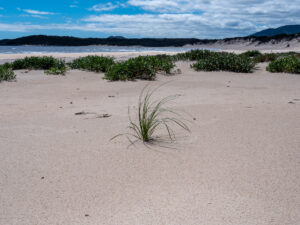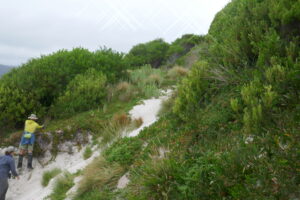SPRATS volunteers achieve 99 per cent reduction in sea spurge over 17 seasons
In January 2023 Wildcare Sea Spurge Remote Area Teams (SPRATS) completed their 17th season, deploying adventure volunteers to locate and treat coastal weeds over 850km of wilderness coastline between Macquarie Harbour and South-East Cape. The SPRATS mission is to systematically manage and ultimately eradicate sea spurge (Euphorbia paralias) and marram grass (Ammophila arenaria) weeds from the south and south-west coasts of Tasmania, an area which includes the entire coastline of Tasmanian Wilderness World Heritage Area (TWWHA).
The TWWHA and the West Coast Conservation Area encompass some of the most intact coastal environments in Australia. In this region, sea spurge and marram grass threaten geodiversity values, Aboriginal cultural sites, coastal herbfields, grasslands and shrublands, as well as habitats for rare and threatened species. These remote coastlines are globally important for migratory birds and are the Tasmanian stronghold for a number of shore-nesting and feeding birds, including the hooded plover, red-capped plover, pied oystercatcher, sooty oystercatcher, and various species of terns. These bird species are at risk due to the ability of sea spurge and marram grass to transform the coastline’s geomorphic structure, making it less suitable for breeding and feeding.
Last year marked 40 years since the declaration of the TWWHA. Critical to retaining World Heritage listing is the ability to demonstrate effective conservation management. The systematic and targeted work of the SPRATS program makes an essential contribution to the management of the TWWHA. SPRATS volunteers get to play their part in protecting habitats of international conservation importance and have fun at the same time. It is highly rewarding work for returning volunteers, who revisit sites that were once overrun by weeds to now find ecologically healthy systems.
To continue the effective management of sea-spurge and marram grass across this remote coastline, the SPRATS Branch is always on the lookout for volunteers with remote-area bushwalking skills who are able to operate safely and productively in these sometimes challenging environments.
Over 17 years, the SPRATS Wildcare Branch has undertaken over 8,500 days work to remove 14.4 million sea spurge plants. Before the SPRATS program began, the number of weeds in the area was estimated at approximately 11.1 million sea spurge plants and 124,000 marram grass clumps. Since then, SPRATS volunteers have reduced the number of sea spurge plants to about 12,850 and marram grass clumps to about 2,800. This is approximately a 99 per cent reduction in sea spurge plants and a 98 per cent reduction in marram grass clumps.
In Summer 2023, 7 teams of 4-5 volunteers spent 12 to 24 days traversing various sections of coast and again recorded reduced numbers of sea spurge and marram plants in the target region. However, other parts of Tasmania, the Bass Strait Islands and South coasts of Australia are recording increasing numbers of new sea spurge infestations, as seeds from heavily infested sites (for example, areas north of Macquarie Harbour) are transported by ocean currents and invade new beaches. To address this growing threat, SPRATS members have contributed to trials for a biological control agent, the fungus Venturia paralias. Preliminary results are encouraging and show that the fungus can survive and spread in Tasmania. If trials continue to demonstrate success, the next challenge for Tasmania will be to procure sufficient stocks of the fungus and to coordinate its release and monitoring. Wildcare could be at the heart of this new and ambitious program which has the potential to greatly reduce the threat of sea spurge spread throughout all of Tasmania’s beaches and dune systems.
Anne Boothroyd
Wildcare SPRATS President

